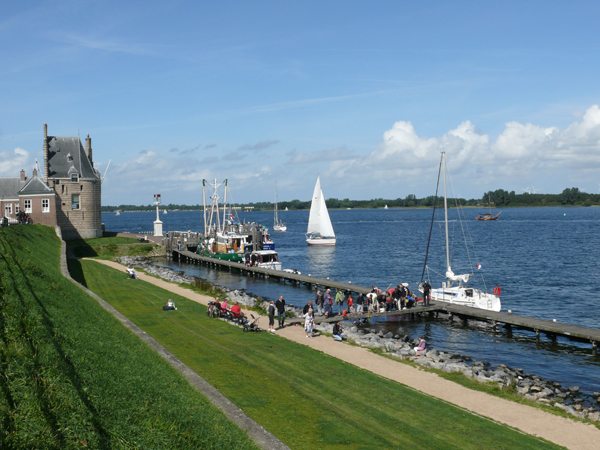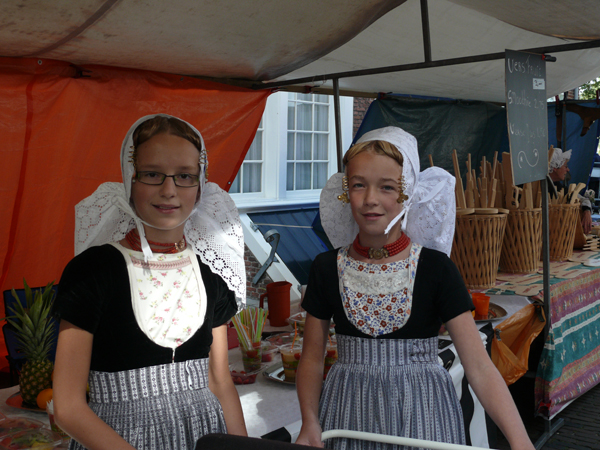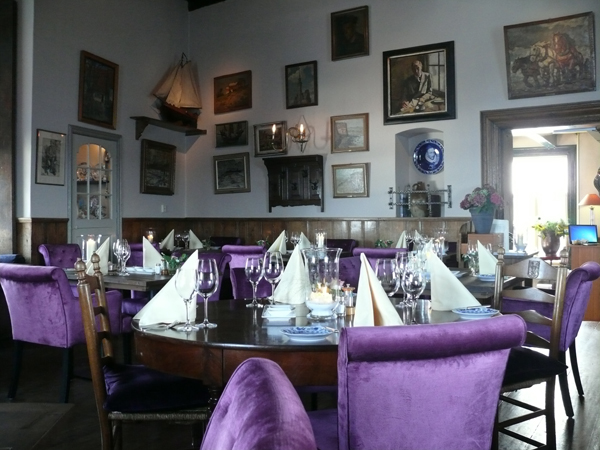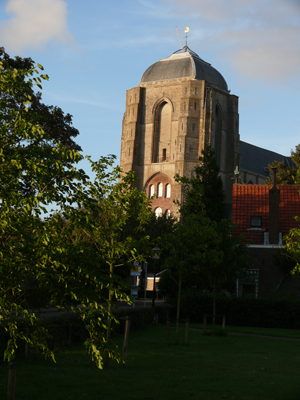VEERE, THE NETHERLANDS – A nattily-attired server makes small talk while settling me into my table overlooking the lovely salt water lake (Veerse Meer) which laps the shores of this tiny town located in enchanting Zeeland, this country’s southern-most state.
Midway through pouring a glass of wine and translating some of the meal options offered on the Auberge de Campveerse Toren’s menu, Mark, the server, stops, smiles and says: “Or maybe you would like me to bring you the meal Prince William of Orange ordered when he visited our establishment (in the latter part of the 1500s).”
Prince William, the Netherland’s controversial monarch whose ancestors still rule this land-challenged country, organized a wedding feast for his third bride, French princess Charlotte de Bourbon, at the Toren (tower) restaurant, which was built between 1358 and 1390 and actually started out as the town’s castle.

Above: The town's lovely harbour dates back centuries.
“Prince William and his guests dined on pheasant, peacock, suckling pig, ham, duck, lobster, a whole veal, a variety of vegetables, pastries and many bottles of wine that day,” says Mark with such accuracy that I start to wonder if he’s not a ghost from the past. Mark even knows the Prince’s final tab.
“He paid the equivalent of about $1,200 in today’s money. The restaurant even made him pay for broken dishes and stolen napkins,” the server reveals.
“They have the prince’s bill in the Veere archives.”
Prince William was so impressed with the food, ambience and service he received at the Toren that sday that he decided to return here a few years later, on Sept. 1, 1583 - the day he married his fourth bride, Louise de Coligny.
“So I have a great responsibility to carry on the tradition of fine service that was started centuries ago,” says the amusing young man who cannot remember what happened to wife No. 3.
The Prince of Orange is not the only notable guest to climb the well-worn, circular stone staircase that leads to the Toren’s tap room. Russian czar Peter the Great (1717) and a whole roster of other European royalty and nobility have also dined in this backwater town’s inn which, according to Mark, has not changed much over time. Modern-day monarchs like the Dutch royal family and the late Prince Rainier of Monaco and his late wife Princess Grace (Grace Kelly) also dined in the Toren.
The first mention of this fortified town that sits behind a North Sea dyke, which I can see clearly from my window table, was in 900BC.

Above: The town's citizens really like to play up their cultural past.
Back then, it was known as Campveere, which explains the restaurant’s name. The town, where artists, inspired by the remarkable light that falls here, have been coming for centuries, was originally named after the ferry that regularly made crossings to Campen, a small fishing village that still exists on the nearby island of Noord-Beveland.
On the opposite side of the harbour from the Toren, a twin tower once stood. It was constructed at the same time as the Toren but in 1630 the soft ground on which it was built crumbled and the twin tower slipped into the lake. Both towers still appear on the town’s coat of arms, however.
The Toren’s history is indeed intriguing but when Mark delivers my first course - lobster and North Sea shrimp covered in a dome of shaved melon slices - he tells me there are even more impressive and important buildings spread throughout the town.
One of them is Veere’s massive Town Hall, a truly lovely structure that was started in 1470 and today ranks No. 2 in importance on the nation’s list of heritage places. One reason for its high standing is the golden cistern housed in a glass case just inside the hall’s main chamber. It’s still used when the country’s Queen comes here on state occasions – as Marquise of Veere she takes the first sip of wine from the beautifully engraved chalice as part of a centuries-old ceremony.
The niches of the Town Hall’s lovely façade are decorated with statues of the ancient family who played the biggest role in Veere’s early rise in European importance – the Van Borseles.
It was through the marriage of a Van Borsele son to the daughter of Scotland’s King James I in the mid 1500s that earned Veere the staple right for Scottish wool. That meant that Veere was the only place in all of Holland where Scottish merchants were allowed to unload their valuable cargo to be traded.

Above: The Auberge de Campveerse Toren has had some very important guests.
That decree from King James propelled tiny Veere into the big leagues of Dutch cities and it became as important a trading centre as Amsterdam, Maastricht or Utrecht at the time. Along with its coffers, the population of Veere also skyrocketed; from just a few hundred before the wool staple was granted to 3,500 at its peak. Mark tells me that number has dwindled back to just 500 now but that half the current population are descendants of the original settlers.
The most striking feature of the Town Hall is its bulbous tower which is crowned with a gold weather vane. The 47 bronze tower bells, which the Nazi wanted to melt town for weapons but thankfully changed their minds, still create heavenly sounds.
The cozy relationship with King James meant that rich Scottish traders also favoured Veere as a place to set up their homes. Two of what’s known as the town’s “Scottish Homes” still dominate Veere’s main street known as the Kaaj, where now modern-day travellers sip wine at harbour-side tables on sunny days.
The most striking of the Scottish Homes is the one called The Lamb House, which was occupied by the Cunningham family and its descendents for over 100 years.
When Mark delivers my main course – a platter of turbot caught right outside the window where I’m sitting – he leaves me to digest the news that the town’s Great Church is where Napoleon housed his troops when he invaded and occupied Veere, thus ending the town’s wool privileges with Scotland and its role as an important trading place.
The massive exterior of the Great Church, which was finished in 1686, truly impresses. However, Napoleon ordered the once decorative interior gutted so the church could be used as a barracks and stables and little has been done since to restore it to its original glory. The Great Church is now used primarily for concerts – the acoustics are said to make it a desired place by musicians and singers.
A giant well located at the back of the church, which once filtered and stored over 200,000 litres of rain water for the town’s use, is the only Tudor-designed building in all of the Netherlands.

Above: Old buildings dominate landscape.
Another interesting tidbit Mark shares with me about the town is that during World War II 600 German soldiers, who were hiding in a 17th century bastion on the other side of the harbour, surrendered to a Scottish regiment, who are remembered on a plaque now hanging on the side of the Town Hall.
The streets of Veere come alive each week with a local market where people in traditional dress – women wearing lace bonnets and long dresses and men decked out in suspenders and folk hats – sell homemade crafts and bake goods to the tourists, most of whom come from neighbouring Belgium and Germany.
The market is a sweet treat, just like the house specialty chocolate cake Mark delivers to end my fabulous Auberge de Campveerse Toren dinner.
It was a meal fit for a king – or at least a Prince of Orange.
Information
The Auberge de Campveerse Toren also offers guest rooms, four of which are located in the main historic tower and look out on the lake.
For more information on the Torfen restaurant, go towww.campveersetoren.nl.
For more information on the Netherlands, go to www.holland.com.